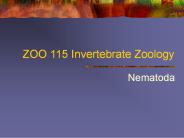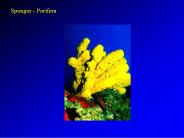Metazoan PowerPoint PPT Presentations
All Time
Recommended
Characterization of Metazoan Ceruloplasmin Ortholog in Chlamydomonas. Blue Copper ... Laccases plants, fungi, archaea, bacteria; oxidizes many different types of ...
| PowerPoint PPT presentation | free to view
noncellular components = intracellular and extracellular body fluids, ... problem w/ R and nutrition thus invaginate/flatten/internal transport systems ...
| PowerPoint PPT presentation | free to view
scolex - the end of the worm specialized for attachment to the ... hatch from embryonated eggs in the large ... in the perianal folds; scotch tape test ...
| PowerPoint PPT presentation | free to view
To model a specific type of negative selection ... Can be overcome by identifying DNA motifs evolving at a slower rate than the ...
| PowerPoint PPT presentation | free to view
Completely sequenced genome could be used for large-scale comparative analysis ... Intra-mammal comparison show a large amount of non-functional conservation, ...
| PowerPoint PPT presentation | free to view
Marcelo Garcia & Claudia A M Russo. Laborat rio Nacional de ... Jukes-Cantor. NJ tree with Tamura-Nei distances for heterogeneous sequences, gamma = 0,5 ...
| PowerPoint PPT presentation | free to view
Metazoan Invertebrates. Mollusca. Gastropods. Shell and viscera twisted 180 ... Metazoan Invertebrates. Arthropoda Trilobites. Swimming or crawling arthropods ...
| PowerPoint PPT presentation | free to download
Non-Coelomate Animals Porifera Simplest metazoan Cell level of organization Few cell types No true tissues Feed on material suspended in water Motile as larva ...
| PowerPoint PPT presentation | free to download
ZOO 115 Invertebrate Zoology Nematoda Phylum Nematoda Common name: round worms 20,000 species. Mostly widespread and abundant of all metazoans 90,000 worms in a ...
| PowerPoint PPT presentation | free to download
Horn corals. Tabulate corals. Modern corals. EARLY PALEOZOIC LIFE. Metazoan Invertebrates ... Rugosa (Rugose or Horn Corals) Ranged from Ordovician to Permian ...
| PowerPoint PPT presentation | free to download
PARASITOLOGY PROTOZOAN METAZOAN HOST-PARASITE RELATIONSHIPS PARASITOLOGY Parasites as vectors for disease PARASITES as portals of entry HEAVY INFESTATIONS ...
| PowerPoint PPT presentation | free to view
Biology 320 Invertebrate Zoology Fall 2005 Chapter 5 Phylum Porifera Phylum Porifera The sponges Name Porifera means pore bearers First metazoan phylum we ...
| PowerPoint PPT presentation | free to view
What are the evolutionary relationships of kinesins? ... Metazoan: mouse/human, fly, worm, fish (Fugu/Danio), frog, tunicate (Ciona) ...
| PowerPoint PPT presentation | free to view
Anthozoa (sea anemones, stony coral) early divergence among metazoans ... sea anemone, corals. Hydra. P. Cnidaria: Body Wall. Epidermis derived from ectoderm ...
| PowerPoint PPT presentation | free to view
polyphyletic origins of metazoa. Syncytial theory. metazoans arose from a ... Polyphyletic: includes species that arose from more than one immediate ancestor ...
| PowerPoint PPT presentation | free to view
... the 'Varanger' glaciation we have the first appearance of putative metazoans. How do we know there were glaciations in the Precambrian? ...
| PowerPoint PPT presentation | free to view
far more of them than all other metazoan species combined ... OPILIONES (harvestmen, daddy longlegs ) PSEUDOSCORPIONES (pseudoscorpions) ...
| PowerPoint PPT presentation | free to view
Mitochondria and plastid genomes of plants and protists (rRNA, tRNA and mRNA genes) ... Metazoan mitochondria. Not found in nuclear or viral genes ...
| PowerPoint PPT presentation | free to view
Biology 320 Invertebrate Zoology Fall 2005 Highlights from Chapter 4 Introduction to Metazoa Metazoans Multicellular organisms Really we are referring to members ...
| PowerPoint PPT presentation | free to view
Organization of Metazoan Bodies. Intracellular Extracellular. Organelles Cytoplasm. Interstitial Blood Plasma. Fig. 9.3. Fig. 9.4. Fig. 9.5. Fig. 9.6c. Skeletal ...
| PowerPoint PPT presentation | free to view
4. Archaean life. 5. Evolution of complexity. 1. What can be known about the evolution of life? ... 4. Archaean life. Lecture 2: Proterozoic life. and metazoans ...
| PowerPoint PPT presentation | free to view
1.The most abundant bacterioplankton have never been cultured. ... The corresponding values for metazoan zooplankton are 10-20%. Egestion of ...
| PowerPoint PPT presentation | free to view
trilobites, crustaceans, scorpions, insects. Sponges ... Marrella (crustacean) most common Burgess Shale fossil. EARLY PALEOZOIC LIFE. THE BURGESS SHALE ...
| PowerPoint PPT presentation | free to download
Value-adding, Access, and Use: Biological Databases as a Case Study
| PowerPoint PPT presentation | free to download
Discussion of the Paper: IDL, the International Database on Longevity Living to 100 Symposium Society of Actuaries Leonid A. Gavrilov, Ph.D.
| PowerPoint PPT presentation | free to download
Now Three Domains and 6 Kingdoms. Conventional Classification of ... Hydra. sea pens. soft corals. 2 tissue layers: ectoderm, endoderm. sea anemones. jellyfish ...
| PowerPoint PPT presentation | free to download
Title: Developmental Biology, 9e Author: Gary M. Lange Last modified by: Administrator Created Date: 10/16/2000 7:08:56 PM Document presentation format
| PowerPoint PPT presentation | free to view
no real tissues, organs or organ systems. they lack--- digestive, excretory, respiratory ... calcareous CaCO2 ~siliceous SiO2. Secreted by. sclerocytes ...
| PowerPoint PPT presentation | free to download
General Zoology Unit Two Have silicon based spicules Sometimes referred to as glass sponges All are deep sea forms Euplectella Some members are of the syconoid form ...
| PowerPoint PPT presentation | free to view
Sponges and Placozoans Chapter 12 * Phylum Placozoa Trichoplax adhaerens is the sole species of phylum Placozoa (marine). No symmetry No muscular or nervous organs ...
| PowerPoint PPT presentation | free to download
... Evolution of nervous systems * Why study the evolution of nervous systems Curiousity May provide fundamental insights into nervous system function and ...
| PowerPoint PPT presentation | free to download
Title: No Slide Title Author: M. Graham Last modified by: Owner Created Date: 2/23/2000 5:45:34 PM Document presentation format: On-screen Show (4:3)
| PowerPoint PPT presentation | free to view
The unfolded protein response signals through high-order assembly of Ire1 Alexei V. Korennykh1,3, Pascal F. Egea1, Andrei A. Korostelev4, Janet Finer-Moore1, Chao ...
| PowerPoint PPT presentation | free to view
Primal Origin of the Freshwater Invertebrates Jerry L. Kaster What is the Geologic Time-Scale History of Freshwater Invertebrates? What are the Colonization Routes of ...
| PowerPoint PPT presentation | free to download
Are very diverse in form and habitat. Most reproduce sexually. Have a characteristic pattern ... 1. Separation of annelids and arthropods into different clades ...
| PowerPoint PPT presentation | free to view
Recall that Bilateralia includes two great groups of organisms Protostomia and ... Beginning of organogenesis. Significant segmentation ...
| PowerPoint PPT presentation | free to download
Microscopic obligate parasites that mostly infect fish. ... two haploid sporoplasm nuclei fuse to complete autogamy; the sporoplasm grows ...
| PowerPoint PPT presentation | free to view
Burrowing also added an important tier to community ... spiders, mites, ticks scorpions,horseshoe crabs. all having feeding appendages called chelicerae ...
| PowerPoint PPT presentation | free to download
Genesis 1:20 And God said, 'Let the water teem with living ... 21 So God created the great creatures of the sea and every ... 1913-1976 (from Wikepedia) ...
| PowerPoint PPT presentation | free to view
Zebrafish Danio rerio
| PowerPoint PPT presentation | free to view
Organellar Introns Organellar genomes contain 3 types of introns: 1. Group I 2. Group II (evolutionary precursors to nuclear mRNA/spliceosomal introns)
| PowerPoint PPT presentation | free to download
How to build cross-species interoperable ontologies Chris Mungall, LBNL Melissa Haendel, OHSU
| PowerPoint PPT presentation | free to view
coelom. 6. Broad Groupings of Kingdom Animalia. 7. Key Transitions ... Coelom poses circulation problem. solved by circulatory system. open circulatory system ...
| PowerPoint PPT presentation | free to view
A comparative overview of the Animal Kingdom * * * * * * * * * * * * * * * * * * * * * * * * * * * * * General Features of Animals Animals are the consumers of the ...
| PowerPoint PPT presentation | free to view
may be first life originate without light (chemosynthesis theory)
| PowerPoint PPT presentation | free to download
Start to out-line (Project proposal-worth 5 points) ... P.s. the ancestor of the last 3 classes share. 1-shelled eggs or viviparity 2-amniotic egg ...
| PowerPoint PPT presentation | free to download
Isolation of the Cdc45/Mcm2-7/GINS (CMG) complex, a candidate for the eukaryotic ... The helicase moves 3' to 5' and is as processive as the Mcm4,6,7 subcomplex ...
| PowerPoint PPT presentation | free to view
Eucaryotic organisms living in/on defined host for all or part of life cycle ... Most other protozoa are nonpathogenic. Vagina: Trichomonas vaginalis. E histolytica ...
| PowerPoint PPT presentation | free to view
Title: No Slide Title Author: Michael Terns Last modified by: Mike Terns Created Date: 11/23/1998 8:19:44 PM Document presentation format: On-screen Show (4:3)
| PowerPoint PPT presentation | free to view
Architectural Pattern of an Animal Chapter 9 * * * * * * * * * * * * * * * * * * * * * The Appearance of Major Body Plans The Cambrian explosion marks the earliest ...
| PowerPoint PPT presentation | free to download
Recently arrived in the UK to work with Seth Bullock at University of Southampton. Prior to that, I obtained my PhD from the University of Queensland in Australia, ...
| PowerPoint PPT presentation | free to view
Inner surfaces lined with flagellated collar cells (choanocytes) ... Skeleton of calcareous or siliceous crystalline spicules and/or protein fibers (spongin) ...
| PowerPoint PPT presentation | free to view
increase in body size possible (follows from 1) storage area for organs, separates organs from gut ... http://sorrel.humboldt.edu/ ~els15/Zoo314.html ...
| PowerPoint PPT presentation | free to view
Intermediate filaments are major components of the nuclear and cytoplasmic cytoskeletons. ... re encoded by a large and complex gene superfamily ...
| PowerPoint PPT presentation | free to download
Proteomics research on the entirety of proteins (so far in an organism) coined ... omics - used to describe large-scale approaches (whereby large is sometimes 1) ...
| PowerPoint PPT presentation | free to view
Tim Hulsen1, Wilco W.M. Fleuren1, Peter M.A. Groenen2 1CMBI, Radboud University Nijmegen Medical Centre, Nijmegen 2MDI, Organon NV, Oss Introduction
| PowerPoint PPT presentation | free to download
























































